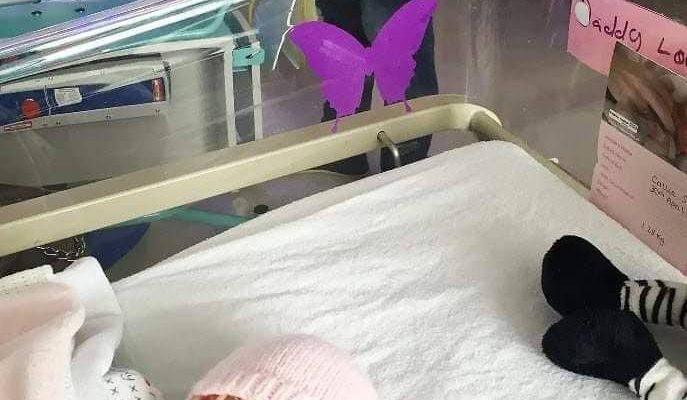Millie Smith and Lewis Cann found out they were having twin girls, but only one of them would survive.
Smith gave birth to identical twins Callie and Skye on April 30, following a high-risk pregnancy that lasted 30 weeks. Skye only lived for three hours.
Without her sister, Callie spent the night in the NICU incubator under the watchful eyes of her adoring and distraught parents.
An exhausted mother of healthy newborn twins told Smith, in all candor, that she was “so lucky” not to have two infants.
The statements devastated the new mother, and she was at a loss for words. Then she saw the purple butterfly and knew that Skye’s legacy was to comfort other bereaved parents.
Millie Smith and her partner, Lewis Cann, welcomed their first child in November 2015.
Smith, who is expecting a pair of daughters and whose family includes many sets of twins, reported a “gut feeling” that she was carrying more than one baby.
The British parents were shocked to find out that their unborn child had a deadly disease less than two weeks after they found out they were expecting twins.
“During the scan, the doctor didn’t say anything. I was very excited and loved seeing the little babies, but she was silent. Both Lewis and I immediately knew there must be a problem,” Smith said.
The CDC reports that approximately 1 in 4,600 newborns in the United States are born with anencephaly; thus, the doctors broke the news that one of the babies had the condition.
Because of the severe nature of this birth abnormality, “almost all babies born with anencephaly will die shortly after birth.”
The parents went forward with the extraordinarily high-risk pregnancy while knowing that one of their babies would likely die shortly after birth.
Smith and Cann gave their daughters, who were born months later, the names Skye and Callie.
“We knew that Skye needed to have a name before she was born,” Smith said. “Knowing she would only survive for seconds or minutes, I wanted her to be named during that time.”
The meaning behind “Skye,” she explained, symbolized “somewhere we knew she would always be, that we could look up at the sky and remember our baby.”
On April 30, Smith went into labor at just 30 weeks along, necessitating a quick C-section.
The pair was provided with a “bereavement midwife” and a “Daisy Room,” a space where parents can be with their infant before and after death, to help them cope with the loss.
“When the girls were born, they both cried. This was a huge moment, as we were told that Skye would not make a noise or move,” said Smith, who was thankful to have spent three hours with Skye before she died.
“We were cuddling Skye when she passed away. This was the worst moment in our lives. I have never ever felt heartbreak like that before. But I am proud that she fought for so long to spend time with us.”
Callie was one of three sets of twins staying in the NICU while they all recovered from being born prematurely.
“Most of the nurses were aware of what had happened, but as time passed, people stopped talking about Skye. After about four weeks, everyone acted as though nothing had happened, meaning the families around me had no idea about our situation,” Smith recalled.
Innocuously, Smith was told that she was “so lucky” not to have twins by a frazzled mother whose twins were also in the NICU.
“None of the other parents knew what had happened or anything about Skye. The comment was completely innocent and more out of humor…They weren’t to know that I did at one point have two.” Smith continued, “But the comment nearly broke me. I ran out [of] the room in tears and they had no idea why. I didn’t have the heart to tell them what had happened. A simple sticker would have avoided that entire situation.”
Smith then knew she had to make something that would speak for parents who had just lost a child so that this kind of miscommunication would never happen again.
She created a poster for the neonatal intensive care unit to inform staff and visitors that a purple butterfly on the incubator indicated the loss of one or more babies in a set of multiples.
“I chose butterflies, as I felt it was fitting to remember the babies that flew away, the color purple because it is suitable for both boys or girls,” said Smith.
The Skye High Foundation, which oversees the purple butterfly initiative, has helped expand the idea to hospitals in many different nations.
Callie, now 7, is full of life and joy, and her memory continues on in purple butterfly cards and other programs to support families who have lost a baby like Skye.
Purple butterfly merchandise currently includes a wide variety of gifts and accessories.
“Ultimately I will never be able to stop this from happening, but the more support groups we can set up and put things in place like the stickers the better it will be. It’s the hardest thing anyone has to deal with,” Smith said.
The world is fortunate to have compassionate people like Millie Smith who are working to ease the suffering of those who have experienced the loss of a child of any age.
Please SHARE this story so others know what a purple butterfly next to a newborn means!



